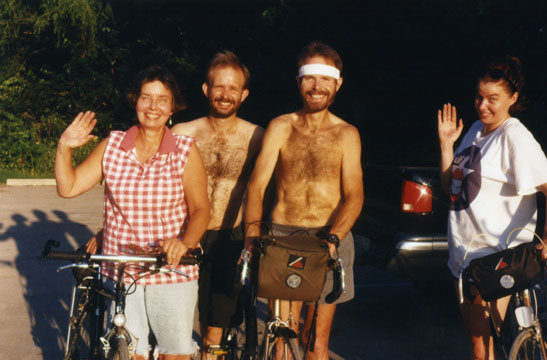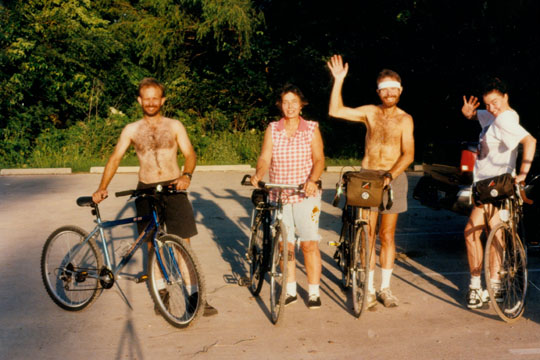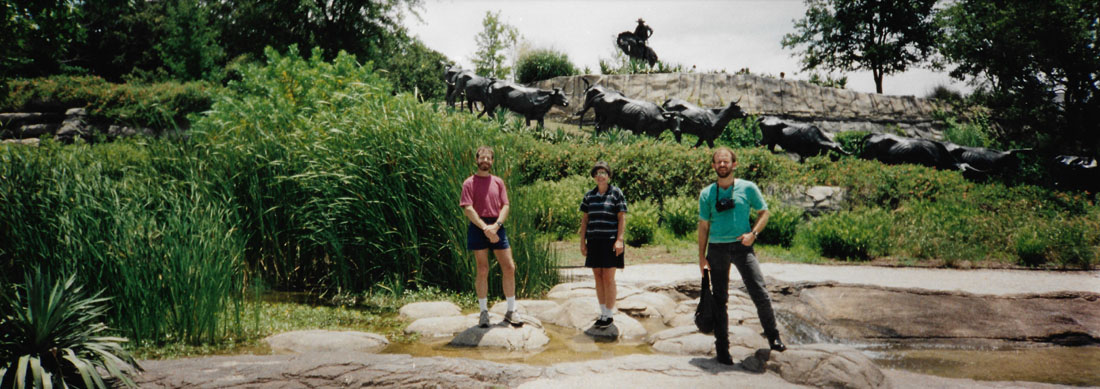


 |
July 15-20, 1997: Our Summer Trip to Yellowstone National Park |
 |
June 7, 1997: My Mom Moves to Dallas |
 |
Return to the Index for 1997 |
Judy had wanted to get to Dallas as soon as possible after Momís move, so we thought the best thing was to give Mom a week or so before she came. She arrived on the 14th, Saturday, and went home a week later on the 22nd. Of course, most of the time, we were over at my Mom's condo where Judy helped her get things arranged and made lists of what new stuff Mom might need. Judy and I went shopping during the week, when I could get off work, and we bought things like a little kitchen table and a microwave cart.
On the two weekends, when Fred was down here, we had a few little outings with her, and almost all the pictures we took were on those outings. The first one we took was on Sunday the 15th when we went to the Dallas Zoo.
An Outing at the Zoo
|
(I might point out that now, in 2015, it is a lot easier to get there. I could simply drive a mile down Inwood, park my car at the light rail station, and take the train to the Zoo. Although I wasn't a fan of all the money that was spent on the Dallas Light Rail System, it has made getting to the Fairgrounds and to the Zoo much easier. One day, it will make getting to the airport easier as well.)
The Dallas Zoo dates from the spring of 1888 when a man from Colorado City offered to sell two deer and two mountain lions to the City of Dallas. The animals were purchased by the City for $60 and placed in pens in City Park- the only city-owned park until 1904, when the City purchased Fair Park. Since the Zoo had outgrown City Park, in 1910 the entire collection moved to Fair Park, making it the second home of the Dallas Zoo.
The growing State Fair crowded the Zoo out, and in 1912 the Zoo moved to its current location- Marsalis Park in Oak Cliff. In 1922, a special zoo commission raised $10,000 for the zoo, and the number of animals increased from 161 in 1920 to 1,065 in 1925. One of the first major acquisitions, Queenie the elephant (d. 1955), was purchased with pennies, nickels and dimes donated by the schoolchildren of Dallas. The Zoo was upgraded in the late 1930s as a WPA project. It included an extensive system of concrete and natural stone bridges, park houses, winding walks, hillside stairways, and retaining walls along with new monkey cages, large animal dens and paddocks, and wild fowl cages. There was also a new building that served as both commissary offices and an entrance.
By the 1940s, the Dallas Zoo was one of the 10 largest zoos in the country, and in 1955, the Dallas Zoological Society was founded as a non-profit support group for the zoo to raise the necessary funds to purchase new animals for the collection.
|
A a long-range strategic plan and new funding led to a new chimpanzee habitat, a new childrenís zoo, a new animal health care facility and new primate exhibits. Through the combination of private gifts and bond funds, the Zoo opened a lemur exhibit (1995), the Primate Place (1996) and the Kimberly-Clark Chimpanzee Forest (1997).
Again, I might note that the Zoo in 2015 is almost nothing like it was on our visit this year. Many new exhibits have been opened and new facilities constructed. Private funding increased significantly in the first decade of this century, and this has made the Dallas Zoo one of the premier attractions in the Southwest.
|
We saw lots of interesting animals on our walk through the zoo this afternoon, not the least colorful of which was this female saddle-billed stork. Below are clickable thumbnails for the various pictures that Fred and I took this afternoon:

|
The Zoo is just a short distance south of downtown, and as we pulled out of the parking lot and up to the expressway, there was an excellent view of downtown Dallas spread out in front of us.
An Unfortunate Incident
Since Judy was in and out all day, I didnít think it necessary to educate her on the alarm system. Consequently, we only set it when I was at home and all of us went out. I didnít think there would be a problem during the day, but I didnít count on one of my neighbors holding one of her frequent garage sales. There will be more to say much later about this particular neighbor, but suffice it to say that she is the only one who holds garage sales. She lives at the opposite end of my building, so the people that stop have to drive behind our building, alongside my unit, and then around the front and back to Inwood. When she has these sales, there is a steady stream of traffic all day long. While I donít like the traffic and the congestion, it hasnít been a security problem in the past as I have either been at home or the alarm has been set.
On Friday, June 20th, though, I did not set the alarm when I left for work, and I didnít tell Judy how to set it, either, because when I left, the sale had not started and I did not know there was going to be one at all. Had I known, I might have done things differently. Even then, there might not have been a problem, except for one other coincidence. Occasionally, when the front iron gate is closed, the lock does not catch and it has to be locked with the key. Judy did not know this, and when she left in mid-morning to go to Momís, she just locked the front door and pulled the gate closed. It did not lock, though, and apparently swung back open again.
I can only surmise that someone patronizing the garage sale drove around the front of the house as Judy was leaving, and they saw her go. Seeing that the gate was ajar, I think they returned shortly, again under cover of all the traffic at the sale, and rang the doorbell. Getting no answer, they brazenly kicked in the front door. Had the alarm been set, it would have started beeping, alerting them that there WAS an alarm, and they might have not stuck around. But it wasnít set, so they proceeded to take what they could as quickly as they could.
Judy returned home in the early afternoon to find the front door broken in and a portable TV sitting in the front hall. She called me at work and I came home immediately. We found that TVs had been taken from the two upstairs bedrooms, along with the VCRs that were with them. My camera had been taken from where it hung on the hall hat rack, and all the cowboy hats, mine and Fredís, had been taken as well. The TV from the kitchen was the one found in the front hall, and we can only think that the burglars were surprised by someone coming along and had to drop that TV and run for it. We just canít be sure. They also, for some reason, took Grantís cologne collection, possibly because it was sitting on a Nambe pewter platter- which much have looked like silver to them.
Fortunately, they did not have a chance to get the actual silverplate from the dining room. Nor did they have a chance to get to the family room to rip off the electronics up there- either because they didnít know the room was there, or because the route to it and back to the front door was too long, or perhaps because they were interrupted. All together, the loss totaled about $5,000 and, although the insurance company paid for everything, there were items that could not be replaced- like Grantís platter. I guess I was lucky that they didnít get more stuff, but what they got was enough to make me feel completely violated.
Judy, of course, thought it was all her fault, but of course it wasnít. There were just a number of individual coincidences- the garage sale, the alarm, the front gate- that came together at unfortunately the same time. Had any one of them not occurred, neither would the break-in, I think. Anyway, it took me quite some time to get a list of everything taken and get it to USAA, but they were very understanding and paid the claim with little question. The TVs were easy to replace, as were the VCRs. The platter and colognes were one of a kind and were never replaced. After a while, Fred and I got new cowboy hats on a trip to Austin, and of course I paid for Fredís as the insurance paid me for it.
The camera was the hardest thing to replace. I suppose I should have got something new, but I liked that Canon A-1 a great deal. The A-1 is no longer made; I have had that camera since about 1972, and it has been everywhere with me. I canvassed pawn shops and second hand camera shops looking for one, and finally found a used one at KEH Cameras up on Forest Lane. I never could get the same case that I had, but at least I have the same camera I was used to. All in all, the experience could have been much worse had the burglars had more time, or perhaps had the burglary occurred at night or while I was gone out of town. But oftentimes burglars are not sophisticated (except in the most high-end planned burglaries) enough to know what is really valuable. Grantís Blue Danube china collection, for example, was worth four or five times what the burglars could possibly have gotten for all the electronics that the stole. I am thankful that they didnít make it to the family room and my desk (money and credit cards and more electronics) or to the drawers in the bedroom (Grantís jewelry and watches). But what they got was enough.
A Bike Ride at White Rock Lake
|
So we drover over to one of the parking lots at the northwest corner of the lake, got the bikes out of the truck and prepared to set off. We usually go south along the western shore of the lake on the bike path there, and then cross the dam at the south end of the lake. The bike path continues north from the spillway along Garland Road to a point just south of the Arboretum, where the bike path turns west to generally follow the lakeshore up the eastern side. The trail ends when bikers cross the Mockingbird Bridge at the north end of the lake and get back to the starting point.
Fred had his tripod in the truck, so we set it up to take a couple of pictures of the four of us at the beginning of our ride, and two of these pictures are below:
 |
 |
A Sunday Afternoon in Downtown Dallas
|
Then we would head five or six blocks northwest to the Allied Bank Building and its beautiful fountains.
The Farmer's Market and City Hall were just as we expected, and soon we were parked at Pioneer Plaza. Pioneer Plaza is a large public park located in the Convention Center District downtown. It contains a large sculpture and is a heavily visited tourist site. Adjacent to the plaza is the Pioneer Park Cemetery which features the Confederate War Memorial. Together, they are the largest public open space in the Dallas central business district.
|
The plaza and its accompanying sculpture were the idea of real estate developer Trammell Crow, who wanted an iconic "Western" sculpture in the city of Dallas and assembled a group to donate the sculptures. The $9 million project was begun in 1992 on 4.2 acres of land donated by the City of Dallas; $4.8 million of the cost came from private funds raised from individuals and local businesses.
The fact that the sculpture that Crow commissioned, of longhorns being herded by cowboys, was historically inaccurate (the nearest that cattle drives ever came to Dallas was 40 miles away in Fort Worth), was ignored. Local artists sued to stop the project, claiming that the historical fiction would make Dallas seem even more pretentious than many folks already thought it was, but the suit failed and the project opened on time in 1994.
Today the park is maintained by the adjacent Dallas Convention Center and is the second most visited tourist attraction in downtown Dallas. (If you can't figure out what the most visited site is, you have to be living under a rock; think "second gunman" or "grassy knoll".
|
The inaccuracy comes from the fact that most of the cattle driven along the Shawnee Trail weren't Texas Longhorns at all; most of those weren't numerous in cattle drives until after the Chisolm Trail became the preferred route. The 49 bronze steers and 3 trail riders sculptures were created by artist Robert Summers of Glen Rose, Texas.
Each steer is larger-than-life at six feet high; all together the sculpture is the largest bronze monument of its kind in the world. Set along an artificial ridge and past a man-made limestone cliff, native landscaping with a flowing stream and waterfall help create the dramatic effect.
Fred got out his panoramic camera and did a nice photo of the three of us and the Longhorns sculpture:
 |
This installation is actually a work in progress; an additional steer is occasionally added to the herd. Four or five have been added since it opened, and I suspect a few more will be as well.
|
On the northwest side, there are again rows of cypress trees and then one large open air fountain. The fountain consists of a square with ten or twelve holes on a side- maybe a hundred altogether. The fountain is programmed to send water up through these holes to form geometric shapes, or curtains of water or other formations.
The sprays in this computer-controlled fountain come up in varied patterns, are fun to watch and very restful. Surrounding the fountains themselves are numerous cypress trees, lending an air of quiet in the midst of downtown.
|
Here are clickable thumbnails for more of the pictures that we took here at the Allied Bank Plaza:
 |
We very much enjoyed Judy's visit, and she was very helpful in getting Mom situated. I was sorry to see her go on Monday, and we both hope she will return soon and often.
You can use the links below to continue to another photo album page.
 |
July 15-20, 1997: Our Summer Trip to Yellowstone National Park |
 |
June 7, 1997: My Mom Moves to Dallas |
 |
Return to the Index for 1997 |